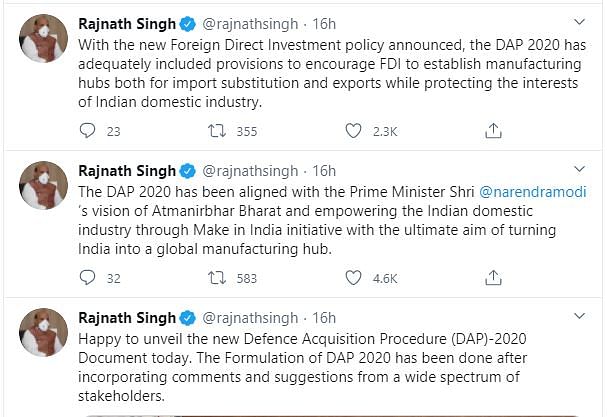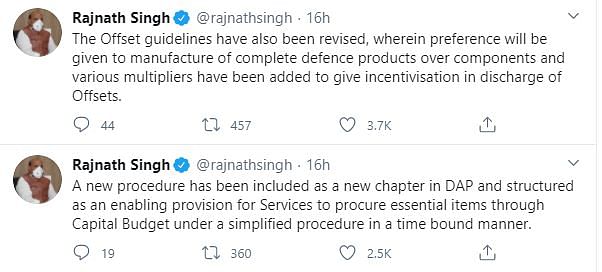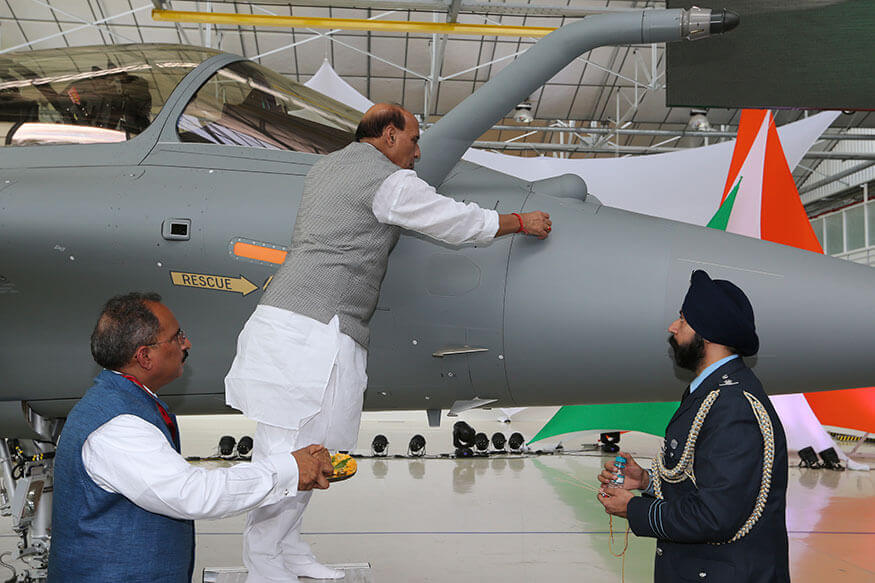On 28 September, Indian Defence Minister Rajnath Singh announced the country’s new Defence Acquisition Procedure—the DAP-2020—which serves as the government’s principal guidebook for defence procurements, replacing the 2016 Defence Procurement Procedure (DPP). With the aim of aligning military acquisition procedures with Prime Minister Narendra Modi’s Atmanirbhar Bharat vision, which stresses on the need for self-reliance, Singh said that the new policy has been designed to empower domestic industries and turn the country into a global defence manufacturing hub through the Make in India mission.
A crucial feature of the DAP-2020 is the scrapping of the erstwhile DPP’s offset clause for inter-governmental agreements (IGA) and single foreign vendors. Along with this, the new policy also introduces categories that encourage domestic manufacturing of equipment parts, Maintenance, Repair, and Overhaul (MRO) facilities for military equipment through subsidiaries, and a clause that paves way for the Ministry of Defence (MoD) to lease military equipment.

The offset clause, introduced under the DPP-2005, obliged international players to invest in India’s domestic defence industry in exchange for technology and equipment purchases. Since defence deals are usually expensive, the Indian government wanted portions of these contract values to either technologically develop the country, contribute to skills development, or generate employment in indigenous industries. As per a 23 September report submitted by India’s revenue watchdog, the Comptroller and Auditor General (CAG), the offset mechanism was established with the tripartite aims of “a) partially compensating for a significant outflow of a buyer country’s resources in a large purchase of foreign goods (b) facilitating induction of technology and (c) adding capacities and capabilities of domestic industry”.
The 15-year-old offset policy, which was amended several times since 2005, eventually required foreign suppliers signing contracts valued above INR 2,000 crores to invest 30% of the value of their deals back into the country. However, the CAG’s recent report, which audited offset agreements till March 2018, showed that 46 such contracts were signed for INR 66,427 crore, and by December 2018, only INR 11,396 crore of the expected INR 19,223 crore—59% of the offsets—had been fulfilled. Of these, the MoD only accepted 48% of the offset claims, since the rest were rejected or pending due to deficiencies in technical evaluation parameters set by the Indian Air Force. The CAG stated that, despite the fact that the remaining commitments of around INR 55,000 crore will be due by 2024, the discharge rate will prove to be a major challenge in the timely fulfilment of these commitments.
In particular, the controversial INR 60,000 crore Rafale fighter jet IGA deal with French manufacturer Dassault Aviation was expected to facilitate Make in India initiatives through their 50% offset deal. However, the CAG said that the company has still “not confirmed” the expected transfers to India’s Defence Research and Development Organization (DRDO). Along with missile company MBDA, Dassault was supposed to discharge 30% of their offset contract by September 2015 by offering high-end technology to the DRDO. By April 2016, the DRDO had picked six new equipment to be delivered from the vendors under their offset obligations, but the firms “did not agree on the transfer of five technologies as most of them were not within the vendor’s core competence”.
Therefore, using the Rafale deal as the precedent, the CAG concluded that foreign vendors were not earnest about fulfilling their offset commitments. Further, Apurva Chandra, Director-General of Acquisitions, said that doing away with the offset clause would bring down administrative costs in IGA and ab initio single vendor contracts. The shrunk scope of offsets in the DAP-2020 is now only confined to contracts that involve materiel purchases from international suppliers via competitive bidding.
Amit Cowshish, a former acquisitions financial advisor to the MoD, however, points out that the Ministry’s justification for restricting offsets was known even when the policy was introduced in 2005, but the government had still made the conscious choice to bear the additional costs of monitoring and policing the contracts, too, if it meant that the country’s “fledgeling defence industry” would be strengthened by the introduction of global technologies and integrated with the international supply chain.
The reduction of the scope of the policy, therefore, is supposed to relieve the MoD of these additional costs and also provides incentives for foreign vendors to enter contracts, as it would no longer require them to navigate the complex and underdeveloped offset regulations mechanisms. Further, a cleaner acquisitions process without any strings attached by way of offsets would also reduce the risk of large deals like the Rafale from turning into scandals at the cost of the MoD.
Under the new policy, the MoD also claims that several categories of arms acquisitions will be reserved for vendors owned by Indian resident citizens. Furthermore, a new purchase category has been introduced, wherein foreign supplier acquisitions must include local manufacturing and technology transfers. Singh said that the DAP-2020, along with the country’s new Foreign Direct Investment (FDI) policy, would encourage the establishment of manufacturing hubs for exports and import substitutions while preserving the domestic interests.
However, as Cowshish notes, new policies that have hiked the FDI cap to 74%, may not necessarily incentivize foreign parties to invest in India, as they will still be subjected to stringent prior and post-approval scrutiny and reviews that are entirely at the discretion of the government, whose national security interests may contrast with those of vendor governments. Further, the FDI case posited by the DAP-2020 is weakened by embargoes imposed by the Indian government on 101 defence imports, which are set to come into effect over the course of five years, beginning in December 2020. There is also a high scope for the sanctions to be extended to a larger variety of items, adding to the MoD’s pressure of acquiring indigenously developed materiel to meet its increasing military demands.
It is also interesting to note that the new clause which allows the MoD to lease equipment and technology from foreign vendors—introduced to reduce costs—does not have much of a precedent in the international system, even though India has resorted to this a few times in the past. For example, India operates a Russian nuclear attack submarine on lease, and last March signed a $3 billion deal to lease the Chakra III, which is likely to arrive at Indian waters by 2025.
In terms of achieving self-reliance in the long-term, though, the only comparable policy that comes to mind is the United States’ Lend-Lease policy during the Second World War, where American arms and equipment were leased out to Allied powers, bolstering its domestic military-industrial complex. If India wishes to be taken seriously as an emerging global military power, it is not enough for it to cut costs by leasing foreign equipment; it must simultaneously bolster indigenous manufacturing to lease defence equipment and vessels to its smaller neighbours and allies in the Indo-Pacific. This would advance their joint efforts to contain Chinese military supremacy in the region, and thus challenge Beijing’s role as the primary provider to these countries.
An official at an Indian defence PSU, wishing to remain anonymous, told Statecraft that scrapping the offset regulation was a “bad decision”; rather, efforts towards generating more compliance could have been achieved by withholding the 30% payment subjected to the submission of bills of Indian purchases. He said that while the MoD’s move of releasing a list to purchase locally-produced materiel is complaint with Atmanirbhar defence, the offset regulation was also intrinsic to making India self-reliant. While it may not instantly bring advanced technology to the country, the introduction of high-end tech could have been beneficial in the long run. Highlighting that India still imports engines for everything—from cars to fighter jets—he also argued that better negotiation and compliance within the existing offset clause could have incentivized vendors to invest. Until India begins to manufacture engines, a crucial primary import, he believes that Indian defence cannot be truly Atmanirbhar. However, he signalled hope that the new leasing policy would encourage foreign companies to loan equipment and technology to Indian defence in the hopes of entering future contracts.
In sum, the DAP-2020 has attempted to reduce burdens on vendors and the government by limiting the offset clause—a welcome move—but also introduces new and more complex mechanisms with the addition of chapters on the procurement of communication and information technology systems as well as post-contract management. Cowshish pointed out that attempts to privatize domestic defence productions in the past were unable to realize their true potential due to a lack of timely and bold execution, and this may continue to hinder progress in the sector. As South Asian geopolitics and regional threats to India’s national security continue to be fraught, an uncomplicated and clean acquisitions process would be the way forward to boosting domestic defence industries while incentivising foreign parties. Yet, the DAP-2020 continues to provide an unclear answer as to whether any system has been put in place to ensure that roadblocks to acquisitions programmes are removed so as to avoid complications and non-compliance for existing deals.

